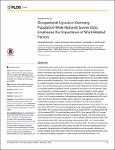Occupational Injuries in Germany: Population-Wide National Survey Data Emphasize the Importance of Work-Related Factors
Rommel, Alexander
Varnaccia, Gianni
Lahmann, Nils
Kottner, Jan
Kroll, Lars Eric
Unintentional injuries cause much of the global mortality burden, with the workplace being a common accident setting. Even in high-income economies, occupational injury figures remain remarkably high. Because risk factors for occupational injuries are prone to confounding, the present research takes a comprehensive approach. To better understand the occurrence of occupational injuries, sociodemographic factors and work- and health-related factors are tested simultaneously. Thus, the present analysis aims to develop a comprehensive epidemiological model that facilitates the explanation of varying injury rates in the workplace. The representative phone survey German Health Update 2010 provides information on medically treated occupational injuries sustained in the year prior to the interview. Data were collected on sociodemographics, occupation, working conditions, health-related behaviors, and chronic diseases. For the economically active population (18–70 years, n = 14,041), the 12-month prevalence of occupational injuries was calculated with a 95% confidence interval (CI). Blockwise multiple logistic regression was applied to successively include different groups of variables. Overall, 2.8% (95% CI 2.4–3.2) of the gainfully employed population report at least one occupational injury (women: 0.9%; 95% CI 0.7–1.2; men: 4.3%; 95% CI 3.7–5.0). In the fully adjusted model, male gender (OR 3.16) and age 18–29 (OR 1.54), as well as agricultural (OR 5.40), technical (OR 3.41), skilled service (OR 4.24) or manual (OR 5.12), and unskilled service (OR 3.13) or manual (OR 4.97) occupations are associated with higher chances of occupational injuries. The same holds for frequent stressors such as heavy carrying (OR 1.78), working in awkward postures (OR 1.46), environmental stress (OR 1.48), and working under pressure (OR 1.41). Among health-related variables, physical inactivity (OR 1.47) and obesity (OR 1.73) present a significantly higher chance of occupational injuries. While the odds for most work-related factors were as expected, the associations for health-related factors such as smoking, drinking, and chronic diseases were rather weak. In part, this may be due to context-specific factors such as safety and workplace regulations in high-income countries like Germany. This assumption could guide further research, taking a multi-level approach to international comparisons.
Dateien zu dieser Publikation
Keine Lizenzangabe

